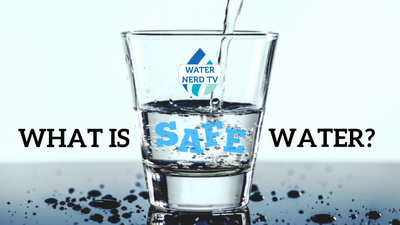Analies Dyjak | Policy Nerd
As emerging contaminants like GenX, PFOA, and PFOS have been popping up in news headlines all over the country, there has been some confusion as to how these unregulated contaminants are addressed at the federal level. While it may seem like the Unregulated Contaminant Monitoring Rule is in place to protect people from any and all emerging contaminants, it is not a hard and fast rule designed to expedite regulation -- rather, it is a lengthy process that unfortunately has not resulted in many real-world changes. This article discusses aspects of the Unregulated Contaminant Monitoring Rule that may surprise you, and explains how drinking water contaminants become regulated in the United States.
What Is The Unregulated Contaminant Monitoring Rule?
The Unregulated Contaminant Monitoring Rule (UCMR) was created as a part of the 1996 Amendments of the Safe Drinking Water Act (SDWA). SDWA regulates all public drinking water systems throughout the United States. It establishes National Primary Drinking Water Regulations for 90 contaminants, which are known as Maximum Contaminant Levels (MCLs). UCMR is the process that EPA uses to regulate contaminants. However, it has ultimately failed to create meaningful changes in water quality regulation.
How Are Drinking Water Contaminants Regulated In The United States?
Under the Safe Drinking Water Act, EPA typically follows a specific process when determining whether to regulate certain contaminants. Every 5 years, EPA publishes a list of 30 contaminants under the UCMR called the Contaminant Candidate List (CCL). Contaminants on this list are not regulated by National Primary Drinking Water Regulations, but are most likely present in public drinking water systems. These contaminants are placed on the list because they pose the greatest public health risk through ingestion of drinking water. EPA’s job is to whittle down the list of 30 to a handful of priority contaminants. Of that group of priority contaminants, EPA must make a regulatory determination for at least 5. EPA can choose to regulate all, some, or none of these contaminants.
What Is The Criteria For UCMR Regulatory Determination?
- EPA must determine that the contaminant does/does not cause adverse health effects in humans.
- EPA must determine if the contaminant will be present in public drinking water systems at an unsafe concentration.
- EPA Administrator must determine if regulating the contaminant will reduce adverse health effects in humans.
Does A Contaminant Have To Be On The CCL To Become Regulated?
No. EPA is not limited to regulating contaminants that are on the current CCL. EPA can consider other contaminants if they present a serious public health concern in drinking water.
Does the Unregulated Contaminant Monitoring Rule Set Drinking Water Standards?
No. UCMR/CCL contaminants are not subject to regulation. As a part of the UCMR program, EPA establishes Minimum Reporting Levels (MRLs) for each contaminant. National Water Quality Laboratory defines MRLs as ”the smallest measured concentration of a substance that can be reliably measured by using a given analytical method.” MRLs are not to be confused with Maximum Contaminant Levels (MCLs), which are enforceable regulatory thresholds for drinking water contamination.
How Are Contaminants Added To The Contaminant Candidate List?
In order for a contaminant to be considered for the EPA UCMR, it must be registered in the United States and have an analytical reference standard. The National Drinking Water Advisory Council and National Academy of Sciences are instrumental in determining which contaminants should be added to the list. After UCMR 2, EPA allowed for public participation in the CCL decision making process. Additionally, a contaminant can be added to multiple CCLs. For example, Perchlorate was on CCL 1, CCL 2, and CCL 3 before it was regulated.
Common Contaminants Considered Under The Unregulated Contaminant Monitoring Rule
The Third Unregulated Contaminant Monitoring Rule (UCMR 3) was published in May of 2012, and it included two chemicals that you might be familiar with. Perfluorooctanesulfonic acid (PFOS) and Perfluorooctanoic acid (PFOA) were both on Contaminant Candidate List 3. Both of these contaminants fall under a broad category of contaminants called PFAS, which are found in heat resistant and non-stick products such as Scotchguard, Teflon, and fire fighting foam. Unfortunately, neither PFOS or PFOA made it to the Regulatory Determination Assessment Phase, and both were removed from regulatory consideration.
What Is The Contaminant Candidate List?
The Fourth Unregulated Contaminant Monitoring Rule (UCMR 4) is the current batch of contaminants that’s under consideration for a regulatory determination. It was published in December of 2016, and includes nine cyanotoxins, two metals, nine pesticides, three disinfection byproducts, three alcohols, and three semivolatile organic chemicals.
Our Take:
While the 1996 Safe Drinking Water Act Amendments provided regulatory due diligence, they also created an unbearably extensive review process. Industrial manufacturing companies are unrestricted when it comes to developing new products, and chemicals pushed to the market are essentially “safe” until proven otherwise. This sort of regulatory approach comes at a serious cost to human health. Chromium 6 is the best example of the flawed regulatory framework for drinking water. The 2000 blockbuster movie “Erin Brockovich” discussed the dangerous toxicity of Chromium 6 and it still isn’t regulated, nor does it appear on the most recent Contaminant Candidate List (CCL 4). The most important takeaway from the EPA UCMR is that once a new CCL is published, the contaminants on the old list don’t just go away. Millions of Americans are forced to deal with adverse health effects because “scientific uncertainty” didn’t allow for regulation. This regulatory framework can't keep up with the thousands of new contaminants that are currently present in the environment.
Other Articles We Think You Might Enjoy:Municipal Drinking Water Compliance: What You Need To KnowWhy Is The Toxic Substances Control Act Important For Drinking Water?Key Things To Know About Getting Your Water Tested



